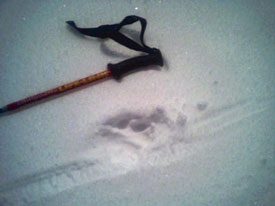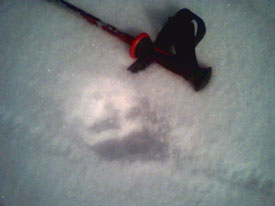

While neither of these pictures (taken with my cell camera) is the greatest, you get the impression this is no ordinary dog track.
It’s one thing to see animal tracks in the snow, but it’s another thing entirely to see the tracks of a large and rare predator.
A friend and I were taking advantage of some fresh, late-season snow and a beautiful day by getting a couple of runs in on a favorite backcountry stash south of Teton Pass. We were near the top of the climb when my friend noticed what we first thought were very large dog tracks coming down the top hundred feet or so of the skin track. The inch of new snow, slightly warmed by the sun, was the ideal medium to record the imprint. We wondered why a dog would be walking down this part of the hill without a human. It was apparent that we were the first two people on top that day; no one else had skinned up the track ahead of us or, after further investigation, from any other direction (there’s really only one approach to this spot and we were on it). And it was very obvious that these tracks were fresh—very fresh.
We noticed the tracks just above where it veered off to the southeast (the animal’s right). Once on top, we were able to follow the tracks across the top of the small peak. We observed where the animal had stopped to sniff around—after having followed a much smaller animal’s tracks for a few yards—and had come up from the west side of the hill completely unaccompanied by any other tracks—human or otherwise. While neither of us are trained animal trackers, both of us can profess some knowledge of indigenous animal tracks of the Tetons. We looked hard at some very good prints: we made note of the pad shapes and positions, the presence of claw marks, the apparent gait of the animal, and the very large size of the prints themselves. It was our combined, unprofessional opinions that these were indeed the tracks of a wolf.
After taking a couple of pictures with the camera on my cell phone (not the greatest, as you can see) and discussing the very real possibility of there being a wolf in this part of the southern Tetons, we skied some lovely, creamy spring snow.
My partner, being less than enamored with the skiing, decided to head out after that run. I, on the other hand, wanted to enjoy the beauty of the day and the spring conditions. I also wanted to get another look at those tracks and see where they went.
On my next skin up, and upon reaching the point where the wolf took sudden departure of the ridge toward the southeast, I could see clearly where it had headed across the glade just below. Funny thing though, we had looked for such a track not twenty minutes before and it was definitely not there. Upon closer inspection of the track, I realized that the animal must have been coming down the hill when it either heard or smelled us, stopped close enough to the edge of the ridge to take a look, and then took off in the opposite direction. It must also have then waited out of sight, just below the ridge, for us to pass and then continued across the glade.
This was a little freaky: having been in a wolf’s sights without us seeing it. We strive to be respectful of the nature around us as we engage in it, but this kind of encounter certainly gives one a renewed awe of and respect for the wildness that is so close around us here in the greater Yellowstone ecosystem. Seeing the animal would have been impressive, no doubt; but seeing only tracks and deciphering just what the animal had done only moments before is, in my mind, a much more valuable experience.
—Chris
